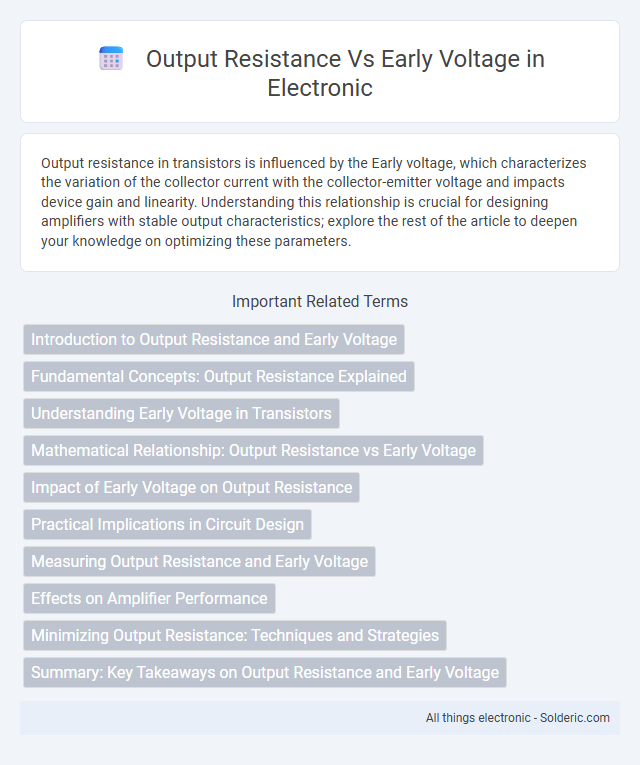Output resistance in transistors is influenced by the Early voltage, which characterizes the variation of the collector current with the collector-emitter voltage and impacts device gain and linearity. Understanding this relationship is crucial for designing amplifiers with stable output characteristics; explore the rest of the article to deepen your knowledge on optimizing these parameters.
Comparison Table
| Parameter | Output Resistance (ro) | Early Voltage (VA) |
|---|---|---|
| Definition | Resistance looking into the output terminal of a transistor | Voltage parameter representing base-width modulation effect |
| Symbol | ro | VA |
| Units | Ohms (O) | Volts (V) |
| Physical Meaning | Determines the transistor's output impedance | Indicates the variation of collector current with collector voltage |
| Relation | ro VA / IC (collector current) | Intrinsic parameter affecting output resistance |
| Typical Range | kO to MO (depends on transistor and bias point) | 10 V to 100 V (varies by device technology) |
| Impact on Amplifier | Higher ro improves voltage gain and output linearity | Higher VA leads to larger ro and better output characteristics |
Introduction to Output Resistance and Early Voltage
Output resistance in transistors measures how much the output current changes with variations in output voltage, directly impacting amplifier gain and linearity. Early voltage quantifies the influence of base-width modulation on output characteristics, providing insight into the device's intrinsic gain and output resistance behavior. Understanding these parameters helps you optimize transistor performance in analog circuit design for better stability and signal fidelity.
Fundamental Concepts: Output Resistance Explained
Output resistance in transistors refers to the small-signal resistance looking into the output terminal, significantly influenced by the transistor's Early voltage (V_A). The Early voltage represents the extrapolated intersection point of the transistor's output characteristic curves and quantifies channel-length modulation effects, which cause finite output resistance. A higher Early voltage corresponds to lower channel-length modulation and results in increased output resistance, improving amplifier gain and linearity.
Understanding Early Voltage in Transistors
Early voltage is a key parameter in transistors that influences output resistance by representing the voltage at which the output current tends to extrapolate to zero, reflecting the device's channel-length modulation effect. Higher Early voltage values indicate lower output conductance, resulting in increased output resistance that improves amplifier gain stability. Understanding Early voltage helps you predict and optimize transistor behavior in analog circuit design by assessing its impact on output resistance.
Mathematical Relationship: Output Resistance vs Early Voltage
Output resistance (r_o) in transistors can be mathematically expressed as r_o = V_A / I_C, where V_A is the Early voltage and I_C is the collector current. The Early voltage represents the extrapolated voltage at which the collector current would theoretically become zero, reflecting the transistor's intrinsic gain and channel length modulation effects. Understanding this linear inverse relationship helps you optimize amplifier performance by controlling the output resistance through adjustments in Early voltage or operating current.
Impact of Early Voltage on Output Resistance
The Early voltage (V_A) directly influences the output resistance (r_o) of a bipolar junction transistor (BJT), with higher Early voltage values leading to increased output resistance. This relationship is expressed as r_o = V_A / I_C, where I_C is the collector current, indicating that output resistance inversely depends on collector current and scales with Early voltage. A larger Early voltage reduces channel-length modulation effects, improving transistor gain stability and linearity by increasing output resistance.
Practical Implications in Circuit Design
Output resistance in transistors significantly impacts voltage gain and linearity, which directly ties to the Early voltage parameter controlling the channel length modulation effect. A higher Early voltage indicates lower output resistance, enhancing amplifier performance by reducing signal distortion and improving gain stability. Understanding this relationship helps you optimize transistor biasing and load conditions for robust and precise analog circuit designs.
Measuring Output Resistance and Early Voltage
Measuring output resistance involves applying a small AC signal to the transistor's output and analyzing the resulting voltage and current changes to determine its linearity and stability. Early voltage is obtained by extrapolating the output current-voltage characteristics to the point where the output current would theoretically become zero, indicating the transistor's intrinsic gain and channel length modulation effects. Understanding your output resistance and Early voltage is crucial for optimizing amplifier performance and predicting device behavior under varying load conditions.
Effects on Amplifier Performance
Output resistance directly impacts the gain stability and linearity of a transistor amplifier, where a lower output resistance typically enhances load driving capability. Early voltage influences the output resistance by modeling the intrinsic gain and channel length modulation effects; higher Early voltage values reduce output resistance variability, resulting in improved voltage gain consistency. Together, minimizing output resistance and maximizing Early voltage contribute to increased amplifier gain, reduced distortion, and better frequency response, essential for high-performance analog circuit design.
Minimizing Output Resistance: Techniques and Strategies
Minimizing output resistance in transistors is crucial for enhancing amplifier performance and linearity. Techniques such as increasing Early voltage (V_A) through process optimization and device scaling directly reduce output conductance, thereby lowering output resistance (r_o V_A / I_C). Utilizing cascoding and negative feedback configurations further mitigate output resistance by controlling channel-length modulation effects and stabilizing gain across varying operating conditions.
Summary: Key Takeaways on Output Resistance and Early Voltage
Output resistance is inversely proportional to Early voltage, making Early voltage a critical parameter in transistor performance characterization. A higher Early voltage indicates lower output resistance, enhancing gain stability and improving amplifier linearity in analog circuits. Understanding this relationship is essential for optimizing transistor models in designing reliable and high-performance electronic devices.
Output resistance vs Early voltage Infographic

 solderic.com
solderic.com